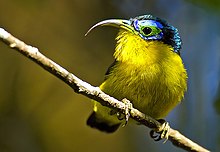Asity
| Asities | |
|---|---|
 |
|
| Yellow-bellied sunbird-asity, | |
| Scientific classification | |
| Kingdom: | Animalia |
| Phylum: | Chordata |
| Class: | Aves |
| Order: | Passeriformes |
| Suborder: | Tyranni |
| Family: |
Philepittidae Sharpe, 1870 |
| Genera | |
The asities are a family, the Philepittidae, of small suboscine passerine birds. The family consists of four species in two genera endemic to Madagascar. The Neodrepanis species are known as sunbird-asities and were formerly known as false sunbirds.
They were thought to have been related to the pittas, hence the scientific name of the family, but a 1993 study suggested that they are actually just a subfamily of broadbills. The morphology of the syrinx is very similar to the Grauer's broadbill of Africa. Here they are considered traditionally as a separate family. Some authors have placed the Sapayoa of South America in the family, although it is now mostly considered a broadbill.
Asities are small forest birds with sexually dichromic plumage and brightly coloured wattles around the eyes of the males. These wattles, which are most conspicuous during the breeding season, get their colour from arrays of collagen fibres. This method of pigmentation is unique in the animal kingdom. Several other features separate them from the broadbills, they possess twelve tail feathers on extremely short (almost non-existent in the Philepitta species) tails, their syrinx is encased with a large bronchial ring and they have forked tongues adapted to nectivory. They have a long outer primary which buzzes in flight, possibly used in signalling during courtship. The two genera are quite distinct.
The major component of the diet of asties is fruit. A wide range of different fruit is taken by the family, and they are among the most important avian dispersers of seeds, as there are very few other frugivorous birds in the forests of Madagascar. They will also take insects. The Neodrepanis sunbird-asities will take nectar, but do so with a long tongue rather than insering their curved bills far into flowers.
...
Wikipedia
